On September 6, U.S. Secretary of Defense Mark Esper, addressing the Royal United Services Institute in London, provided an outline of the major military threats facing the United States. The New York Analysis of Policy and Government provides the key excerpts:
Our strategic competitors, namely Russia and China, [are] learning lessons from studying U.S. military operations over the years. To counter our traditional advantages they are investing heavily into military modernization, while expanding their capabilities in the space and cyber domains. And while the cumulative power of the NATO alliance remains unmatched, some of our comparative advantages have been diminished.
As we look out across the global security environment today, we see a landscape that continues to grow in complexity. It is increasingly clear that Russia and China want to disrupt the international order by gaining a veto over other nations’ economic, diplomatic, and security decisions. And as was the case 45 years ago, we cannot stand idly by while authoritarian nations attempt to reshape the global security environment to their favor at the expense of others. Doing so would invite continued aggression and diminish our ability to deter future conflicts. As such, America’s National Defense strategy makes it clear that great power competition is once again the primary concern of U.S. national security.
The United States is facing this challenge head-on, but if we are to preserve the world all of us have created together through decades of shared sacrifice, we must all rise to the occasion. It is imperative that freedom-loving nations recognize the threats to our security, and commit to doing their part to keep the world safe.
So, let’s start by talking about Russia, since that’s the greatest concern of most European nations. Russia’s invasion of Georgia in 2008, its annexation of Crimea in 2014, its continued aggression in Ukraine, and its efforts to serve as a spoiler to peace in Syria demonstrate Moscow’s unwillingness to be a responsible international actor. Even as far away as Venezuela, we see Russia making allegiances with discredited and failing regimes in an attempt to promote instability. For many years, Russia violated the Intermediate-Range Nuclear Forces Treaty as it continued to build-up its inventory of strategic arms. And right here in the United Kingdom, you know well of the lethal poisonings that occurred in 2006 and 2018.
While Russia lacks the capacity to compete with NATO in conventional terms on a broad regional scale, the threat of a Russian incursion against a neighboring state is one we take very seriously. To put it simply, Russia’s foreign policy continues to disregard international norms. This is why the United States, in consultation with our NATO Allies, is expanding our presence in Poland, and continuing our close collaboration with the Baltic States. The NATO alliance remains vigilant and continues to adapt, to improve unit readiness, to build a more credible deterrence, and to fight and win if necessary.
At the same time, we must contend with a rising China. Decades of robust economic growth – enabled by market reforms – have provided Beijing the financial resources to expand its influence well beyond the shores of the mainland. This alone is not a problem, however, what is concerning is how China is using this new-found economic power.
I saw first-hand how China’s ‘One Belt, One Road’ initiative is manifesting itself throughout the region. What are initially presented as reasonable investments by the PRC to build ports, facilities, and other infrastructure, end up coming with some significant strings attached. The more dependent a country becomes on Chinese investment and trade, the more susceptible they are to coercion and retribution when they act outside of Beijing’s wishes. The political and economic leverage China is gaining by carrying out this strategy has begun eroding the sovereignty of many nations. Ultimately, this influence trickles down to the security arena, and leads countries to make sub-optimal defense decisions for fear of upsetting the Chinese Communist Party and being punished through economic measures or political backlash.
Additionally, China’s technology theft for military gain is Sexual health can be affected by physically or psychologically in both men and 5mg cialis price women. Again, 100mg viagra effects taking the medication according to the extent or gravity of the injury. Earlier, the condition was considered as aging effect that attacked only older low cost viagra http://www.slovak-republic.org/video/ people. order cialis online One of the greatest benefits of taking Kamagra- Apart from the low cost of ponds fifty. staggering. Indeed, every Chinese company has the potential to be an accomplice in Beijing’s state-sponsored theft of other nations’ military and civilian technology. Those companies also pose a risk to the secure and resilient telecommunications infrastructure on which our allies and partners depend for interoperability, intelligence sharing, and mobilization. To quote China’s own cybersecurity law, private companies are required to ”provide technical support and assistance to public security organs and national security organs,” whether they want to or not. Governments and businesses around the world should be concerned by Chinese influence that opens them to costly deals, future coercion, loss of technical advantage, or other malicious activity.
I would caution my friends in Europe – this is not a problem in some distant land that does not affect you. The PRC’s influence is expanding rapidly as it seeks to pursue new partners, or what have historically been known as Chinese tributes, well beyond Asia. But for anyone who wonders what a world dominated by Beijing might look like, I would argue all you need to do is look at how they treat their own people, within their borders. Over a million ethnic minority Uighurs are in re-education camps in Xinjiang Province. Basic civil liberties such as freedom of speech and freedom of the press are routinely denied. And we all see what’s happening to those who continue to speak out against the party’s influence in Hong Kong. I was there for the handover in 1997 when the ”one country, two systems” designation was affirmed – I would ask you: given what we see in Hong Kong today, has China kept those promises?
The United States National Defense Strategy accounts for the realities of today’s environment, with a particular focus on this new era of great power competition. This is not because we are naïve about other threats or seek to rekindle another Cold War. Rather, we are aligned in this focus because of the magnitude of the threats Russia and China pose to U.S. national security and prosperity today, and the potential for those threats to increase in the future.
Deterring potential aggression in the first place, prior to the onset of conflict, is paramount to our Strategy. This is why we are working with our allies and partners to improve our capabilities, capacity, and defense posture throughout our priority regions. With regard to NATO, our top priorities are burden sharing and unit readiness. While we have made great improvements in recent years, we still have a number of allies not meeting the two-percent defense commitment as agreed to under the 2014 Wales Declaration. President Trump has been very clear – and I will continue to push my counterparts – that all NATO members must live up to this obligation. The strength of our collective response requires that all alliance members be ready to do their part when called. Building this readiness demands greater investments so that NATO forces remain the most highly trained and best-equipped in the world.
I want to thank the United Kingdom in particular for your continued strong investments in defense. You are one of the 8 out of 29 NATO members who are meeting this target. Aside from the United States, the U.K. has the largest defense budget within NATO. I would encourage the U.K., regardless of the outcome of Brexit, to maintain this level of defense spending, and to continue demonstrating your commitment to security and the rule of law around the world. I look forward to meeting with my defense counterpart, Secretary Ben Wallace, later today as we talk about ways to continue strengthening the alliance in light of the threats I have spoken about this morning.
In closing – during that same speech from 1946 where Churchill warned us of the ”Iron Curtain” that had descended across the continent, he also spoke of the ”special relationship” that bonded our two nations – one that would serve to prevent war and to preserve the newly created international order. That ”special relationship” remains just as vital today as it was when Churchill first coined the phrase. If we are to preserve the peace and order that our nations sacrificed so much for in the past, we must remain vigilant, committed, and prepared to respond to aggression where it threatens our interests. I am confident that we will continue to work closely together to maintain the freedoms we worked so hard to achieve.
Photo: The aircraft carrier USS Dwight D. Eisenhower returns to its homeport of Norfolk, Va. (DoD)

